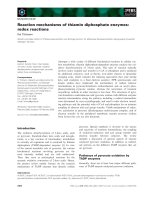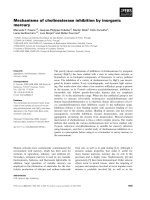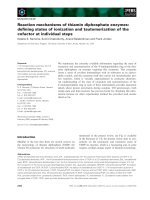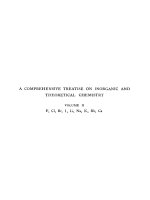Inorganic reaction mechanisms vol 4
Bạn đang xem bản rút gọn của tài liệu. Xem và tải ngay bản đầy đủ của tài liệu tại đây (36.57 MB, 420 trang )
www.pdfgrip.com
www.pdfgrip.com
A Specialist Periodical Report
Inorgan ic Reactio n
Mechanisms
Volume 4
A Review of the Literature Published between
July 1973 and December 1974
Senior Reporter
A. McAuley, Department of Chemistry, University of Victoria,
Victoria, British Columbia, Canada
Rep0 rters
J. Burgess, University of Leicesfer
J. S. Coe, King’s College, London
D. N. Hague, Universify of Kent
R. D. W. Kemmitt, University of Leicesfer
P. Moore, Universify of Warwick
K. L. Scott, Ross foods, Grimsby
M. A. R. Smith, Bruker-Physik AG, Karlsruhe, West Germany
G. Stedman, Universify College, Swansea
0Copyright 1976
The Chemical Society
Burlington House, London WIV
OBN
www.pdfgrip.com
ISBN: 0 85186 285 3
ISS N :0305-8255
Library of Congress Catalog No. 73-642977
Printed in Great Britain by
Adlard & Son Ltd.
Bartholomew Press, Dorking
www.pdfgrip.com
Foreword
The format, coverage and approach to this fourth volume dealing with Inorganic
Reaction Mechanisms are similar to those for the previous volumes of the series.
Rather than attempting to refer to all articles in which there is mention of mechanism, we have chosen (with an eye on volume size and cost!) to concentrate on papers
in which kinetics and mechanisms in solution form the principal interest. This policy
inevitably leads to mention of some papers being cursory with a consequent loss of
subtlety. We hope, however, that any resultant oversimplificationor misrepresentation is minimal. Review articles cited are those which should be accessible to the
great majority of readers.
The period of coverage of the literature is from July 1973 to December 1974. The
boundaries at both ends are somewhat vague since not all libraries have issues available at the same time. Care has been taken to ensure that an overlap with Volume 3 is
maintained in all areas. Material which is derived from Chemical Abstracts rather
than from the original source is indicated by inclusion of a Chern. Abs. citation in the
reference quoted. References to the Russian literature derived from this source
quote the page number of the original article whereas those giving the title of the
English translation quote the page number of the translation.
As in previous volumes, kinetic data are reported in the form (Ea and log A or
A H * and AS*)or units (SI or other) used in the original article, although some
conversions have been made both in the text and in the tables where comparisons are
required.
The Reporters are grateful to many of their colleagues for helpful comments. We
are particularly indebted to Professor W. C. E. Higginson and Drs A. G. Sykes,
G. Davies, R. J. Cross, and A. G. Lappin for their critical reading of sections of the
manuscript.
A. MCAULEY
www.pdfgrip.com
www.pdfgrip.com
Contents
~~
Part I Electron Transfer Processes
Introd uction
Chapter 1 Reactions Between Two Metal Complexes
By K. L. Scoff
3
5
1 Reducing Agents
Chromium(n)
Vanadium@)
Iron@)
LanthanidHn) Ions
5
5
11
13
17
2 Oxidizing Agents
Cerium(1v)
23
23
23
Iron(ru)
3 Miscellaneous Redox Reactions
26
4 Electron Exchange Reactions
32
Chapter 2 Metal Ion-Ligand Redox Reactions
By A. McAuley
1 Chromium(v1)
36
36
41
3 Mangan@u~) and Manganesdvu)
45
4 CoWt(m)
48
5 Vanadium(v)
53
6 Thallium(m)
54
7 Cerium(1v)
55
www.pdfgrip.com
vi
Contents
9 Miscellaneous Redox Reactions
10 Halogens and Halogenate Ions
65
11 Metal Ion Reductions
71
12 Pulse Radiolysis Studies
75
Chapter 3 Reactions of Water and Hydrogen Peroxide
By A. McAuley
Part / I
61
80
Substitution and Related Reactions
Chapter 1 Non-metallic Element
By G. Stedman
1 Group I11
Boron
Boron-Hydrogen Compounds
Boron-Nitrogen Compounds
Boron-Oxygen Compounds
Aluminium
Gallium
Indium
93
93
93
93
94
95
95
96
96
2 GroupN
Carbon
Silicon
Germanium
Tin
Lead
96
96
97
99
100
102
3 GroupV
Nitrogen
Phosphorus
Oxoanions
Compounds with Nitrogen
Phosphazenes
Intramolecular Processes
Arsenic
Antimony
Bismuth
102
102
104
104
106
107
107
108
108
109
www.pdfgrip.com
vii
Contents
4 GroupVI
Oxygen
Sulphur
Selenium
Tellurium
109
109
109
113
113
5 GroupVII
Fluorine
Chlorine
Bromine
113
113
113
114
6 GroupVIII
Xenon
114
114
Chapter 2 Inert Metal Complexes: Co-ordination Numbers
Four and Five
By J. S. Coe
1 Square-planar Complexes
Platinum(I1)
General
Aquation and Hydrolysis
N-Donor Ligands as Entering Groups
S-Donor Ligands as Entering Groups
Steric Effects
Bidentate Entering Groups
Displacement of Bidentate Groups
Ring Closure
Isomerization
cis and trans Effects
Bridged Complexes
Miscellaneous
Palladium(Ii)
Unidentate Entering Groups
Bidentate Entering Groups
Isomerization
Miscellaneous
Nickel@)
Gold(Ir1)
Rhodium@
Copper(I1)
115
115
115
115
115
116
116
117
117
118
118
119
120
122
122
122
122
124
124
125
125
126
126
127
2 Tetrahedral Complexes
127
3 Five-co-ordinate Complexes
128
www.pdfgrip.com
Contents
viii
Chapter 3 Inert Metal Complexes: Co-ordination Numbers
Six and Higher
By P. Moore
129
1 Introduction
129
2 Aquation: Cobalt(n1) Complexes
Unidentate Leaving Groups
Multidentate Leaving Groups
Effects of Non-leaving Ligands
[Co(en),LX]Z+Complexes
[CoL.,XJ+ Complexes
Dioximato-complexes
Bridged Dicobalt Complexes
Solvent Variation
Catalysed Aquation
Photochemistry
133
133
136
137
139
140
146
148
151
152
158
3 Aquation: Chromium(m) Complexes
Unidentate Leaving Groups
Ammonia Loss
[Cr(H,O) 5L]n+Complexes
Other Complexes
Multidentate Leaving Groups
Effects of Non-leaving Ligands
Bridged Dichromium Complexes
Non-aqueous Soivents
Catalysis
Photochemistry
161
161
161
1 62
163
1 66
167
167
168
168
170
4 Aquation: Other Complexes
d l : Molybdenum(v)
d : Molybdenum(1v)
d : Moly bdenum(nr)
d 3: Rhenium(Iv)
d4: Ruthenium(1v)
d4: Osmium(iv)
d 6: Iron@)
d &: Ruthenium(m)
d ti : Rhodium(m)
d 6 : Iridium(1)
d ti : Iron@)
d I:Ruthenium(u)
d Platinum(rv)
171
171
172
173
173
173
173
174
1 74
175
177
178
180
181
www.pdfgrip.com
Contents
ix
5 Base Hydrolysis
Cobalt(@ Complexes
Chromium(m) Complexes
181
181
186
6 Formation
do: Titanium@)
d : Molybdenum(v)
d3: Chromium(m)
d3: Molybdenum(n1)
d4: Rhenium(@
d : Manganese(n)
d : Iron(n1)
d : Ruthenium(1n)
d o: Iron@)
d : Ruthenium(I1)
d 6 : Cobalt@)
d : Rhodium(m)
d : Iridium(m)
d : Platinum(Iv)
Miscellaneous Metal Ions
187
187
187
187
189
190
190
190
190
191
192
193
196
197
198
198
7 Ligand Exchange and Replacement
Solvent Exchange
Ligand Exchange and Replacement: Unidentate by Unidentate
Ligand Replacement: Multidentate by Unidentate
Ligand Replacement: Unidentate by Multidentate
Ligand Replacement: Multidentate by Multidentate
198
198
199
201
201
201
8 Metal Exchange and Displacement
202
9 Isomerization and Racemization
General
Cobalt@) Complexes
Chromium(n1) Complexes
Intramolecular Rearrangements of Tris-chelate Complexes
Miscellaneous
203
203
203
205
205
206
10 Co-ordination Numbers Greater than Six
Chapter 4 Labile Metal Complexes
By D. N. Hague
1 Complex Formation involving Unsubstituted Metal Ions:
Unidentate Ligands and Solvent Exchange
Main-group Ions
Nickel(@
Transition Metals M2+(except Ni2+)
Metals of Valency Three and Higher
208
209
209
209
210
21 1
21 1
www.pdfgrip.com
Contents
X
2 Complex Formation involving Unsubstituted Metal Ions:
Multidentate Ligands
Main-group Ions
Nickel(@
Transition Metals M2+ (except Ni2+)
Metals of Valency Three and Higher
3 The Effect of Bound Ligands
Reactions in Water
Reactions in Non-aqueous Solvents
Chapter 5 Solvent Effects
By J. Burgess
214
214
215
218
226
228
228
233
236
1 Pure Solvents
Substitution and Solvolysis
Isotope Effects
Non-aqueous Solvents
Formation
Exchange Reactions
Isomerization and Racemization
236
236
236
237
237
239
239
2 Mixed Solvents
Diagnosis of Mechanism
Competition
Dielectric Constant Correlations
Grunwald-Winstein Analysis
Other Methods
Reactions of Known Mechanism
240
240
240
240
242
244
245
3 SaltEffects
246
Part / / I Reactions of Biochemical Interest
By D. N. Hague
1 General
25 1
2 Metal Ion Transport
25 1
3 Metal Complex Formation: Non-redox Systems
253
www.pdfgrip.com
Contents
Part IV
xi
4 Reactions involving Metals in Porphyrins and Related Ring
Systems
Haemoglobin and Similar Molecules
Coenzyme B1 and Similar Molecules
Cytochrome c and other Porphyrin-containing Systems
255
255
260
264
5 Redox Reactions involving Metals in other Biological and
Made1 Systems
268
Organometallic Compounds
Chapter 1 Substitution
By R. D. W. Kemmitt and M. A. R. Smith
275
1 Exchange Reactions
275
2 Substitution in Carbonyls:Carbon Monoxide Replacement
Simple Carbonyls
Polynuclear Carbonyls
Mixed-ligand Carbonyls
Groups VI and VII
Group VIII
Iron
Cobalt
Nickel
Platinum
276
276
277
279
279
280
280
282
284
284
3 Substitution in Carbonyls: Replacement of other Ligands
Group VI
Iron
285
285
286
4 Formation of Carbonyls
287
5 Cyclopentadienyls
288
6 Phosphite Complexes
289
7 Olefin Complexes
290
8 Mine Complexes
Substitution
Format ion
291
291
291
www.pdfgrip.com
xii
Contents
Chapter 2 Metal-Alkyl, -Aryl, and -Ally1 Bond Formation
and Cleavage
By R. D. W. Kemmitt and M. A. R. Smith
293
1 General
293
2 GroupIV
293
293
Titanium
3 GroupVI
Chromium
Molybdenum
4 Group VII
Manganese
294
294
295
295
295
5 Group VIII
Iron
Cobalt
Iridium
Nickel
Palladium
Platinum
296
296
297
298
298
299
301
6 Group1
Copper and Silver
Gold
302
302
303
7 Actinides
Uranium
304
304
Chapter 3 Homogeneous Catalysis
By R. D. W. Kemmitt and M. A. R. Smith
305
I Isomerization
Strained Carbocyclic Systems
Alkenes
305
305
309
2 Disproportionation
310
3 Oligomerization
31 1
4 Ceaddition and Co-oligomerization
3 14
www.pdfgrip.com
Contents
xiii
5 Homogeneous Hydrogenation
Chromium
Ruthenium
Cobalt
Rhodium
Iridium
Palladium
Hydrogen Exchange
316
316
316
318
321
322
323
323
7 Homogeneous Oxidation
325
8 Exchange Reactions
327
9 Carbonylation and Hydroformylation
327
10 Decarbonylation
329
11 Hydrosilylation
329
Chapter 4 insertion Reactions
By R. D.W. Kemmitt and M, A. R. Smith
331
1 Alkenes and Alkynes
33 1
2 Carbon Monoxide
334
3 Sulphur Dioxide
336
4 Metals
339
Chapter 5 Reactions of Co-ordinated Ligands
By R. D. W. Kemmitt and M. A. R. Smith
340
1 Carbonyls and Nitrosyls
Carbonyls
Nitrosyls
340
340
342
2 Alkenes and Akynes
Linear Alkenes and Alkynes
Cyclic Alkenes
342
342
345
3 Other Ligands
348
www.pdfgrip.com
Contents
xiv
Chapter 6 Oxidative Addition and Reductive Elimination
By R. D. W. Kernmitt and M. A. R. Smith
1 GroupVI
Molybdenum
Tungsten
349
349
349
349
2 GroupVLU
Rhodium
Iridium
Palladium
Platinum
350
350
350
353
354
3 Other Elements
356
356
Gold
Chapter 7 Isomerization: Intramolecular Processes
By R. D. W , Kernmitt and M. A. R. Smith
357
1 Groups IV and V
357
2 GroupVI
359
359
360
363
Group Trends
Chromium
Molybdenum and Tungsten
3 GroupMI
365
4 Group VIII: Iron Triad
366
366
366
370
371
372
373
374
374
Iron
Carbonyl and Isocyanide Complexes
Diene Complexes
Large-ring Complexes
Five-Co-ordinate Complexes
General
Ruthenium
Osmium
5 Group VII: Cobalt Triad
ML Complexes
Cobalt
Rhodium
Cluster Compounds
Miscellaneous
Iridium
375
375
376
377
377
378
379
www.pdfgrip.com
xv
Contents
6 Group VIII: Nickel Triad
General
Palladium
Platinum
380
380
380
381
7 Gold
384
Errata
386
Author I ndex
387
www.pdfgrip.com
Abbreviations for Ligands and Solvents
Abbreviations which appear only once in the text are generally defined at their point
of use; those which appear more than once are defined below.
General
R
L
LL
LLL
LLLL
X
Specific
acac
ADP
2’-AMP
3’-AMP
5‘-AMP
AN
asp
ATP
big
biPY
bzac
Cal
CDP
cod
CP
CTP
cyclam
cydta
diars
dien
dien - H
dimetn
diphos
DMF
dmg
DMSO
DNA
dPt
alkyl, aryl
unidentate ligand
bidentate ligand
terdentate ligand
quadridentate ligand
halide (except where otherwise stated)
acetylacetonate
adenosine-5’-diphosphate
adenosine-2’-monophosphate
adenosine-3’-monophosphate
adenosine5 ’-monophosphate
acetonitrile
aspartate
adenosine-5’-triphosphate
biguanide
2,2’-bipyridyl
benzoylacetonate
calmagite [1-(1-hydroxy-4-methyl-2-phenylazo)-2-naphtho1-4sulphonate]
cytosine-5’-diphosphate
cyclo-octadiene
cyclopentadieny 1
cytosine-5’-triphosphate
1,4,8,1l-tetra-azacyclotetradecane
cyclohexane-1,Zdiaminetetra-acetate
0-phenylenebisdimethy 1arsine
diethy lenetriamine
diethylenetriamine minus one nitrogen proton
NN’-dimethylpropane-1,3-diamine
1,2-bisdiphenylphosphinoethane
dimethylfomamide
dimethylglyoximate
dimethyl sulphoxide
deoxyribonucleic acid
dipropylenetriamine
www.pdfgrip.com
Abbreviationsfor Ligands and Solvents
dtc
dto
dtP
dtpa
edda
eddda
edds
edma
edta
edtra
egta
en
Et ,dien
ete
gedta
glu
glY
Hb
hedta
hfac
his
hm
ida
ind
ma1
Me,dien - H
Me ma1
Me tren
mida
mnt
mq
NADH
niox
nta
ox
pada
pdta
phen
Pn
PY
salen
tar
tcne
tea
terPY
2,3,2-tet
tet-a, tet-b
xvii
dit hiocarbamate
dithio-oxalate
diethyldithiophosphate
diethy lenetriaminepenta-acetat e
ethylenediaminediacetate
ethylenediaminediacetatedipropionate
NN '-e thylenediaminedisuccinate
ethylenediaminemonoacetate
ethylenediaminetetra-acetate
ethylenediaminetriacetatoacetate(i.e. quinquedentate edta)
ethylene glycol bis-(2-aminoethylether)-tetra-acetate
ethylenediamine
NNN"N"-tetraethyldiethylenetriamine
4,8-dithia-l,ll-diazaundecane
2,2'-et hylenedioxybis(ethyleneiminodiacet ate)
glutamate
glycinate
Haemoglobin
N-(2-hy droxyet hyl)et hylenediaminet riacetate
hexafluoroacetylacetonate
histidine
histamine
iminodiacetate
indenyl
malonate
NNN"N"-tetramethyldiethylenetriamine minus the nitrogen proton
methylmalonate anion
2,2',2"- tris-(NN-dimethylamino)triethylamine
N-methyliminodiacetate
maleonitriledithiolate
2-methyl-8-quinolinate
nicotinamide adenine dinucleotide (reduced form)
nioxime
nitrilotriacetate
oxalate
pyridine-Zazo-p-dimethylaniline
propylenediaminetetra-acetate
1,lO-phenanthroline
propylenediamine
pyridine
NN'- bis(salicyla1dehydo)et hylenediamine
tartrate
tet racyanoethylene
triethanolamine
2,2',2"- terpyridyl
1,4,8,11-tetra-azaundecane
5,7,7,12,14,1&hexamethyl-1,4,8,11-cyclotetra-azatetradecane
www.pdfgrip.com
xviii
tetren
t fac
thiox
tmd
tmeda
Abbreviationsfor Ligands and Solvents
tetraethylenepentamine
1 , l ,l -trifluoroacetylacetone
monothio-oxalate
trimethylenediamine
NNN’N’-tetramethylethylenediamine
TP
t ripolyphosphate
1,4,8,11-tetra-azacyclotetradeca-4,11trans-14-diene 5,7,7,12,14,14-hexamethyIdiene
triaminotriethylamine
tren
triethylenetetramine
trien
trig1ycine
trigly
triethylenetetraminehexa-acetate
ttha
tu
thiourea
xylenol orange
XY 1
www.pdfgrip.com
Part I
ELECTRON TRANSFER PROCESSES
BY
A. McAULEY
K. L. SCOTT
www.pdfgrip.com
www.pdfgrip.com
introduction
BY A. McAULEY AND K. L. SCOTT
The format of this Part of the Report follows closely that of previous volumes.
Attempts have been made to cover as comprehensively as possible all the areas
involving electron-transfer processes in solution. As in previous Reports, compilations have been made of rate and thermodynamic parameters to allow for ready
comparisons of the data.
Several articles have been published dealing with differing areas of the subject
together with technical aspects. Developments in instrumentation have been brought
up to date,l and the range of rapid-reaction techniques now available for investigations of reactions in solution has been reviewed.2An empirical approach to ligand
effects on the kinetics of substitution and redox reactions3 has been shown to be
applicable to a wide variety of reaction systems and the changes effected on the redox
properties of metal ions on ligand co-ordination have been discu~sed.~
Especially
important in this respect are the stabilization of both cations and anions and backbonding effects. A short review of inorganic reaction mechanisms has been publisheds and mechanistic assignments have been made using terms in empirical rate
laws for both complexation and redox reactions of metal ions in aqueous solution.'
The importance of hydrogen-ion dependences has also been discussed. Reactions of
aquocobalt(m) ions have been described using a phenomenological model for redox
reactions.'
Metal-ion reduction of both mononuclears and dinuclears carboxylatocobalt(rr1)
complexes have been reviewed. There continues to be substantial interest in this
subject and in particular the adjacent-attack mechanism for complexes with simple
monocarboxylate ligands now appears to be well understood. The importance of the
inner-sphere mechanism in reductions by Eu2+ has been amply demonstrated.l0
Gouldll has also illustrated the usefulness of the comparison of rate data from the
reactions of a common oxidant by several reductants. Many workers are currently
involved in attempts to measure first-order rates of electron transfer within precursor complexes. In the search for likely systems, the one chosen by Taube12
M. H. Davies, B. H. Robinson, and J. R. Keefe, Ann. Reports (A), 1973, 70, 123.
'Investigation of Rates and Mechanisms of Reaction, Part II', ed. G. G. Hammes, Vol. 6 in the
series 'Techniques of Chemistry', ed. A. Weissberger, Wiley, New York, 1974.
* V. Gutmann and R. Schmid, Coordination Chem. Rev., 1974, 12,263.
V. Gutmann, Sfructure and Bonding, 1973, 15, 141.
6 A. McAuley, Ann. Reports ( A ) , 1973, 70,487.
6 G. Davies, Coordination Chem. Rev., 1974, 14, 287.
7 I. Bodek and G. Davies, Coordination Chem. Rev., 1974, 14, 269.
8 H. Taube, Ber. Bunsengesellschafr phys. Chem., 1972, 76, 964.
0 A. G. Sykes, Chem. in Britain, 1974, 10, 170.
10 F. R. F. Fan and E. S. Gould, Inorg. Chem., 1974,13, 2639.
11 F. R. F. Fan and E. S. Gould, Inorg. Chem., 1974, 13, 2647.
l a S. S. Isied and H. Taube, J . Amer. Chem. Soc., 1973, 95, 8198.
1
a
3
www.pdfgrip.com
4
Introduction
appears to be yielding the most promising results. A long-lived intermediate has,
however, been identified in a cobalt(~~~)-iron(rr)
electron-transfer reaction.13 The
TlI-TIIII exchange reaction has been shown to be a two-electron transfer without
intermediacy of T.111, and redox potentials have been substantially r e v i ~ e d . ~ ~ , ~ ~
Redox processes have been described in a review of platinum chemistry with
monoammine ligands.la Electron-transfer mechanisms involving organometallic
intermediates have been discussed.17 The increasing use of pulse radiolysis has
resulted in better characterization of the species produced and the acid-base properties of free radicals in solution have been reviewed.18 The correlation between
redox potentials and pKa values of the radicals emphasizes the role and importance
of acid-base equilibria of these species in electron-transfer reactions. Two volumes
on homogeneous catalysis involving metal complexes have been published,’@in
which attempts have been made to systematize the chemistry of reactions of metal
ions with small molecules both inorganic (e.g. 02,N2,CO, etc.) and organic (alkenes
and alkynes).
The increasing interest in the biological aspects of inorganic mechanisms is
reflected in several reviews. Redox reactions of metalloporphyrin complexes have
been discussed20and the principles of catalysis by metallo-enzymes described with
particular reference to proteins interacting with oxygen.21Among several interesting
papers in an excellent two-volume work edited by Eichhorn is one by Sutin on redox
reactions in co-ordination compounds.22
R. D. Cannon and J. Gardiner, Inorg. Chem., 1974, 13, 390.
B. Falcinella, P. D. Felgate, and G . S . Laurence, J.C.S. Dalton, 1974, 1367.
H. A. Schwartz, D. Comstock, J. K. Yandell, and R. W. Dodson, J. Phys. Chem., 1974,78,488.
l 6 K. P. Beaumont and C. A. McAuliffe, Inorg. Chim. ACIU,1974, 8, 105.
l7 J. K. Kochi, Accounts Chem. Res., 1974, 7, 351.
E. Hayon and M. Simic, Accounts Chem. Res., 1974, 7, 114.
l9 M. M. Taqui-Khan and A. E. Martell, ‘Homogeneous Catalysis by Metal Complexes’, Vols. I
and 11, Academic Press, New York, 1974.
2o J. H. Furhop, Structure and Bonding, 1974, 18, 1.
21 J. M. Pratt, in ‘Techniques and Topics in Bio-inorganic Chemistry’, ed. C. A. McAuliffe,
Macmillan, London, 1975.
2 2 N. Sutin, in ‘inorganic Biochemistry’, ed. G . L. Eichhorn, Elsevier, Amsterdam, 1973.
1s
l4
l5
www.pdfgrip.com
1
Reactions Between Two Metal Complexes
BY K. L. SCOTT
1 Reducing Agents
Chrornium(II).-Rate constants and activation parameters for reactions of chromium(r1) and of other reductants are given in Table 1 on p. 17.
One of the major interests with CrII is the determination of the mediating role of
organic 1igands.l The simplest of the inner-sphere mechanisms, designated adjacent
attack, involves an activated complex in which both metal ions are co-ordinated to a
simple ligand, the most common group being carboxylate. Proof that remote attack
could occur with bifunctional organic ligands was eventually obtained in the reduction of the isonicotinamidopenta-amminecobalt(111)complex (1).2 The use of complexes with remote carbonyl groups has enabled Gould3 to add considerably to the
list of reactions proceeding by remote attack. Evidence for this mechanism with the
p-formylcinnamato-complex(2)3comes not only from the very high rate and from
(2)
the form of the rate law [equation (l)] but also from the detection of a short-lived
-d[Co1I1l/dt =
(kl+ kz[H+l)[C0I~~][Cr2+]
(1)
chromium(rr1) carbonyl complex. Complex (2) is particularly interesting in that
mediating action by ten ligand atoms is involved. The intermediate is similar both in
its rate of dissociation (k = 7.6 s-l at 25 "C)and spectrum to the one identified in
the Cr2+reduction of the p-formylbenzoato-complex.4Reduction of the o-formyl-
4
H. Taube, Ber. Bunsengesellschaft phys. Chem., 1972, 76,964.
F. Nordmeyer and H. Taube, J. Amer. Chem. SOC.,1968,90, 1162.
E. S. Gould, J. Amer. Chem. SOC.,1974, 96, 2313.
A. Zanella and H. Taube, J. Amer. Chem. SOC.,1972,94, 6403.
5








